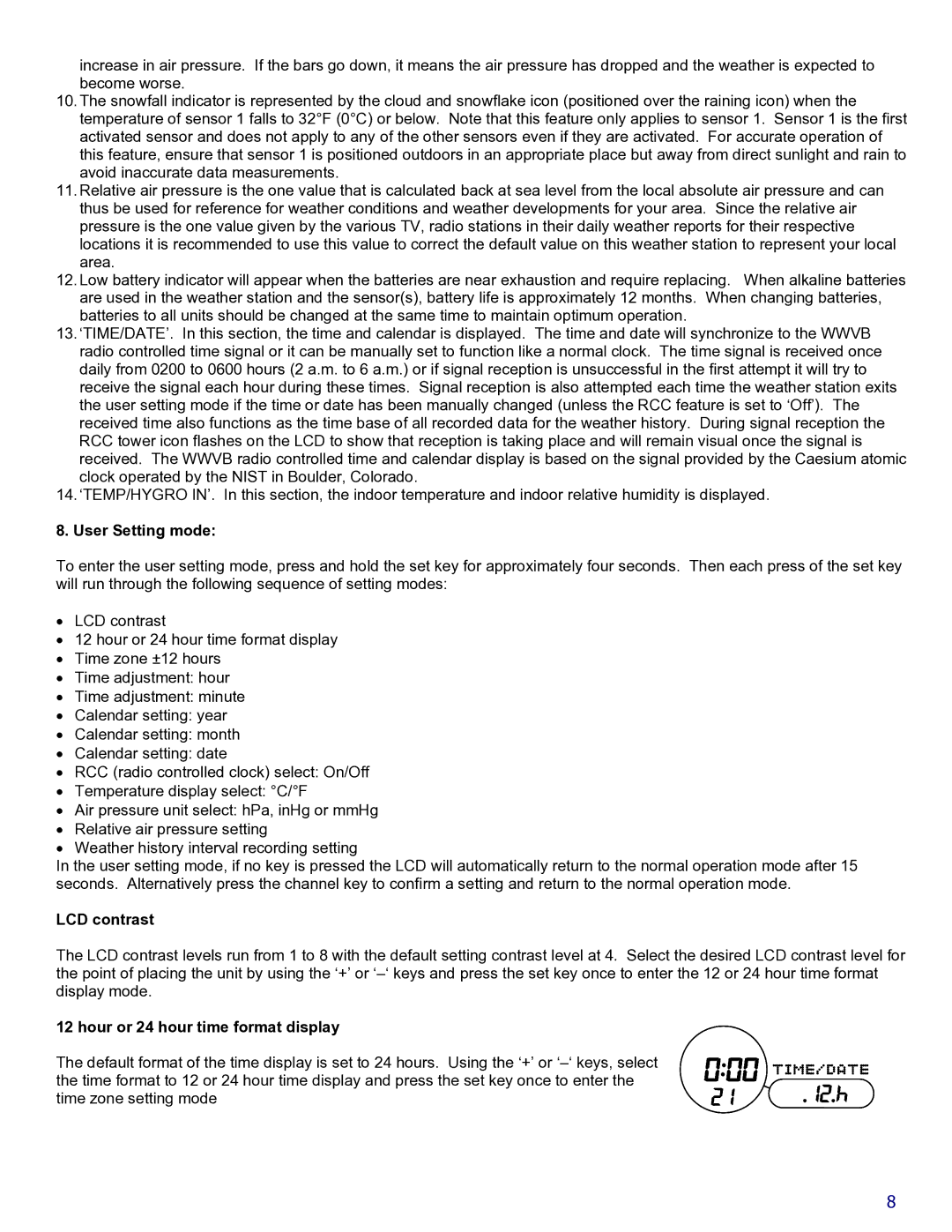
increase in air pressure. If the bars go down, it means the air pressure has dropped and the weather is expected to become worse.
10.The snowfall indicator is represented by the cloud and snowflake icon (positioned over the raining icon) when the temperature of sensor 1 falls to 32°F (0°C) or below. Note that this feature only applies to sensor 1. Sensor 1 is the first activated sensor and does not apply to any of the other sensors even if they are activated. For accurate operation of this feature, ensure that sensor 1 is positioned outdoors in an appropriate place but away from direct sunlight and rain to avoid inaccurate data measurements.
11.Relative air pressure is the one value that is calculated back at sea level from the local absolute air pressure and can thus be used for reference for weather conditions and weather developments for your area. Since the relative air pressure is the one value given by the various TV, radio stations in their daily weather reports for their respective locations it is recommended to use this value to correct the default value on this weather station to represent your local area.
12.Low battery indicator will appear when the batteries are near exhaustion and require replacing. When alkaline batteries are used in the weather station and the sensor(s), battery life is approximately 12 months. When changing batteries, batteries to all units should be changed at the same time to maintain optimum operation.
13.‘TIME/DATE’. In this section, the time and calendar is displayed. The time and date will synchronize to the WWVB radio controlled time signal or it can be manually set to function like a normal clock. The time signal is received once daily from 0200 to 0600 hours (2 a.m. to 6 a.m.) or if signal reception is unsuccessful in the first attempt it will try to receive the signal each hour during these times. Signal reception is also attempted each time the weather station exits the user setting mode if the time or date has been manually changed (unless the RCC feature is set to ‘Off’). The received time also functions as the time base of all recorded data for the weather history. During signal reception the RCC tower icon flashes on the LCD to show that reception is taking place and will remain visual once the signal is received. The WWVB radio controlled time and calendar display is based on the signal provided by the Caesium atomic clock operated by the NIST in Boulder, Colorado.
14.‘TEMP/HYGRO IN’. In this section, the indoor temperature and indoor relative humidity is displayed.
8. User Setting mode:
To enter the user setting mode, press and hold the set key for approximately four seconds. Then each press of the set key will run through the following sequence of setting modes:
•LCD contrast
•12 hour or 24 hour time format display
•Time zone ±12 hours
•Time adjustment: hour
•Time adjustment: minute
•Calendar setting: year
•Calendar setting: month
•Calendar setting: date
•RCC (radio controlled clock) select: On/Off
•Temperature display select: °C/°F
•Air pressure unit select: hPa, inHg or mmHg
•Relative air pressure setting
•Weather history interval recording setting
In the user setting mode, if no key is pressed the LCD will automatically return to the normal operation mode after 15 seconds. Alternatively press the channel key to confirm a setting and return to the normal operation mode.
LCD contrast
The LCD contrast levels run from 1 to 8 with the default setting contrast level at 4. Select the desired LCD contrast level for the point of placing the unit by using the ‘+’ or
12 hour or 24 hour time format display
The default format of the time display is set to 24 hours. Using the ‘+’ or
8
